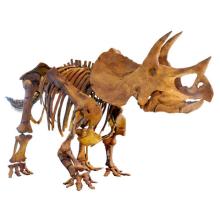Triceratops horridus
Common name:
Triceratops
Genus:
Triceratops
Family:
Ceratopsidae
Suborder:
Neornithischia
Triceratops horridus
Common name:
Triceratops
Genus:
Triceratops
Family:
Ceratopsidae
Suborder:
Neornithischia
Triceratops horridus
Common name:
Triceratops
Genus:
Triceratops
Family:
Ceratopsidae
Suborder:
Neornithischia
Family-Animalia: Ceratopsidae
Ceratopsidae (sometimes spelled Ceratopidae) is a family of ceratopsian dinosaurs including Triceratops, Centrosaurus, and Styracosaurus. All known species were quadrupedal herbivores from the Upper Cretaceous. All but one species are known from western North America, which formed the island continent of Laramidia during most of the Late Cretaceous. Ceratopsids are characterized by beaks, rows of shearing teeth in the back of the jaw, elaborate nasal horns, and a thin parietal-squamosal shelf that extends back and up into a frill. The group is divided into two subfamilies—Chasmosaurinae and Centrosaurinae. The chasmosaurines are generally characterized by long, triangular frills and well-developed brow horns. The centrosaurines had well-developed nasal horns or nasal bosses, shorter and more rectangular frills, and elaborate spines on the back of the frill.
These horns and frills show remarkable variation and are the principal means by which the various species have been recognized. Their purpose is not entirely clear. Defense against predators is one possible purpose – although the frills are comparatively fragile in many species – but it is more likely that, as in modern ungulates, they were secondary sexual characteristics used in displays or for intraspecific combat. The massive bosses on the skulls of Pachyrhinosaurus and Achelousaurus resemble those formed by the base of the horns in modern musk oxen, suggesting that they butted heads. Centrosaurines have frequently been found in massive bone beds with few other species present, suggesting that the animals lived in large herds.

